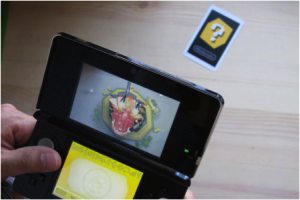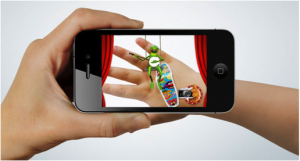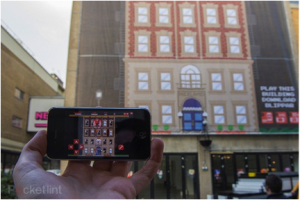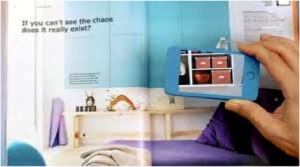 By Ben Freund
By Ben Freund
I decided to challenge myself for this month’s article. I decided I was going to find out what was so exciting about AR technology, and when I figured it out, I’d let you know what it was.
See, my understanding of AR was a little out of date. As far as I knew, there were two kinds of AR, and they both seemed flawed.
What AR Isn’t
First, there was cool futuristic AR where everybody wears glasses or contacts with digital displays. The entire world opens up to reveal layers of information and dazzling illusions to our enhanced vision. Rather like in this video, only hopefully less creepy:
The problem with this kind of AR is that it isn’t happening any time soon. It’s coming, but in the meantime we’ll have to rely on the next few generations of smartphones to distract us from the real world.
The other kind of AR seemed to always involve card markers and gimmicks. This type of novelty perhaps ranked slightly higher than QR codes, but it still seemed to be lacking any real utility. It also didn’t seem to offer much for the future of print media, unless the idea was to transition the industry into producing goofy little cards.
But in the years since AR first stumbled on the scene with these crude markers, it’s become something more than it was, but less than the digital visual revolution yet to come. Today, AR is not yet a mature technology, but it is a mature gimmick, prepared to attract eyeballs, grab attention, and make calls to action.
What AR Is
In other words, it’s a great marketing tool, and it’s achieving this with a major assist from traditional print. One phrase that seems to get thrown around a lot is “the page is the key.” I have to say this didn’t impress me too much when I saw the most literal interpretation of this in Esquire’s recent Augmented Reality Issue:
It seems like a combination of a perfectly good magazine and a perfectly good website that could just as well have existed separately. Nicely done, but seemingly contrived and unnecessary. No new applications, and no reason for the print to exist if it only acts as a gateway to a complete digital experience.
Instead of being impressed by the superslick internationally distributed men’s lifestyle magazine, here’s what first convinced me that AR had something new to offer:
 No traditional ugly card marker here. Instead, the attractive pattern of the Band-Aid acts as a marker that brings in a friendly interactive Muppet to sing away the pain of a cut or scrape. It’s a gimmick, sure, but it offers real added value by reassuring an injured child and does so by relying on existing print media- if you’re willing to call a Band-Aid that.
No traditional ugly card marker here. Instead, the attractive pattern of the Band-Aid acts as a marker that brings in a friendly interactive Muppet to sing away the pain of a cut or scrape. It’s a gimmick, sure, but it offers real added value by reassuring an injured child and does so by relying on existing print media- if you’re willing to call a Band-Aid that.
Current AR still needs visual anchors (with the exception of some imprecise apps that rely entirely on GPS signals) but those anchors can now look like almost anything, and that’s where print gets its chance to shine. Where QR codes act as a gateway to digital resources, AR-enhanced print itself can be a vital part of the experience.
 Here’s a nice example that gadget site Pocket Lint discovered at a recent promotional event for the Disney film Wreck-It Ralph:
Here’s a nice example that gadget site Pocket Lint discovered at a recent promotional event for the Disney film Wreck-It Ralph:
An entire street was turned into an “8-bit’ neighborhood, complete with this giant poster that transforms into a game with the help of AR. The poster plays a role in decorating the street, while the digital element is given a special appeal because of the setting in which it is used. It’s a marriage of form and function.
 I expect the same happy union from Ikea’s upcoming 2013 catalog, which will integrate with an AR program to offer expanded information on any item scanned. It’s a symbiosis of print and digital with some instant gratification on top.
I expect the same happy union from Ikea’s upcoming 2013 catalog, which will integrate with an AR program to offer expanded information on any item scanned. It’s a symbiosis of print and digital with some instant gratification on top.
Go Ahead, Get Excited
It’s these combinations that today’s AR is all about, quickly and painlessly delivering added value in contextually appropriate situations, pushing immediate engagement. No ugly codes and cards. The page is the key, and the page can take any shape and open any door- unlike a lazy QR code that simply links to a URL.
The future of AR isn’t here yet, but the first wave of its truly functional applications has arrived and it’s bringing with it a boost to print. So you’ve got my permission: Get excited.
This is a guest post by Ben Freund on behalf of Xcel Products, an industry leading supplier and converter of adhesives, magnetic sheeting, and other flexible substrates for packaging and retail advertising solutions.











